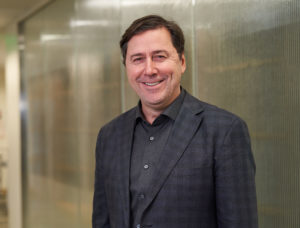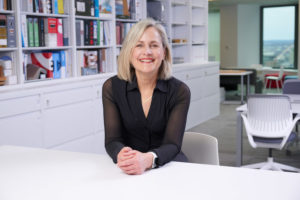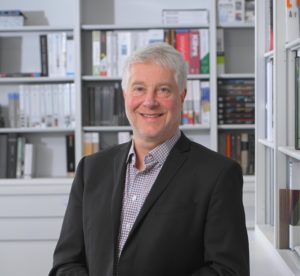ABSTRACTS
Click here to download the Schedule at a Glance.
Click here to download the presenter list.
Click here to download the presenting organization list.
Panel Discussion: Never Too Cold, Never Too Clean
Conor Waddell1, Ana Coppinger2, Craig Leung3
1Lab Works International
2Architecture49
3Conviron
Moderator: Kevin Humeniuk, Architecture49
The objective of this presentation is to cover, in a panel discussion format, the post-pandemic surge of interest in highly controllable spaces including ISO clean rooms, cold rooms and growth chambers and the invaluable early collaborations with manufactures of these specialty environments to meet the increased demand and schedules to achieve sustainability targets.
Early collaboration during the design and delivery of sustainable facilities has proven to be more and more valuable as the demands for high performance scientific environments are ever increasing. The collaborative process is crucial to success but can sometimes come with complexities due to competing functional and technical requirements. Often, projects also involve highly variable work environments of different typologies which must be skillfully integrated or combined. This panel discussion will explore the expertise of its participants to leverage their experience with the integration process of ISO clean rooms, cold rooms and growth chambers in today’s high performing laboratories. This presentation will seek to emphasize the importance of the right collaboration at the right time in order to achieve sustainable lab goals.
The surge of interest for highly controllable spaces in laboratories since the COVID pandemic has opened the door to develop better channels of collaboration between manufactures, designers and stakeholders to meet the realities of designing containment rooms in present times.
 Ana Coppinger is an Architectural Designer at Architecture49 with a deep understanding of planning principles for a wide variety of laboratory typologies. Ana works hands-on with laboratory representatives to assess scientific workflows and processes, and excels in developing planning solutions which optimize the use of space and equipment. Ana is an approachable and dynamic team member who actively listens to clients and understands the core issues before putting forward creative and innovative design alternatives. She has a wealth of experience in design, detailing, and construction phase services. As a speaker on lab planning at numerous conferences in Canada and the USA, Ana’s capabilities in lab planning have been recognized. Recently, she has been invited by the Canadian government to assist in the development of comprehensive lab planning standards for use by the nine federal research departments.
Ana Coppinger is an Architectural Designer at Architecture49 with a deep understanding of planning principles for a wide variety of laboratory typologies. Ana works hands-on with laboratory representatives to assess scientific workflows and processes, and excels in developing planning solutions which optimize the use of space and equipment. Ana is an approachable and dynamic team member who actively listens to clients and understands the core issues before putting forward creative and innovative design alternatives. She has a wealth of experience in design, detailing, and construction phase services. As a speaker on lab planning at numerous conferences in Canada and the USA, Ana’s capabilities in lab planning have been recognized. Recently, she has been invited by the Canadian government to assist in the development of comprehensive lab planning standards for use by the nine federal research departments.
Conor Waddell is a Licensed Professional Engineer with PEO, graduating with a Bachelor’s degree in Mechanical Engineering from University College Dublin in Ireland. He works as a Sales Engineer at Labworks International Inc. assisting clients to develop solutions for Controlled Environmental Rooms and Cleanrooms within the Life Science and Pharmaceutical industries.
Conor has over nine years experience working in technical sales in the Irish, UK, and North American markets. He is an active member in multiple industry associations, including; Sustainable Labs Canada, International Institute for Sustainable Laboratories (I2SL), International Society of Pharmaceutical Engineers (ISPE), American Society of Heating, Refrigeration and Air-Conditioning Engineers (ASHRAE).
At Labworks International Inc. Conor is also part of the R&D team working closely with the Engineering department on developing new technologies to improve clients’ installations with a focus on sustainability and more energy efficient products.
Craig Leung is a graduate of the Bachelor of Science, Biosystems Engineering program at the University of Manitoba. He is an exceptional communicator with strengths in consultation, customer service and cultivating both internal and external stakeholder relationships. His critical thinking, problem-solving mindset and attitude has been invaluable to the diverse set of biotechnology clients including University, Biotech, Cannabis and Government bodies fulfilling their current and future product needs.
 Kevin Humeniuk is Architecture 49’s National Sector Leader for Science & Technology. For the past 18 years, Kevin has been exclusively involved in research laboratory projects as a project manager, project architect and laboratory planner. Kevin has a strong work ethic which ensures reliability and diligence in completing projects. His attention to detail, his strong leadership and management style allow for expression of ideas and solutions surpassing his clients’ expectations. Kevin is a regular presenter at the Canadian Biosafety Symposium and is also a sitting member of the Expert Working Group and the Biocontainment Engineering Science Working Group supporting the development of the Canadian Biosafety Standards and Guidelines.
Kevin Humeniuk is Architecture 49’s National Sector Leader for Science & Technology. For the past 18 years, Kevin has been exclusively involved in research laboratory projects as a project manager, project architect and laboratory planner. Kevin has a strong work ethic which ensures reliability and diligence in completing projects. His attention to detail, his strong leadership and management style allow for expression of ideas and solutions surpassing his clients’ expectations. Kevin is a regular presenter at the Canadian Biosafety Symposium and is also a sitting member of the Expert Working Group and the Biocontainment Engineering Science Working Group supporting the development of the Canadian Biosafety Standards and Guidelines.
Accelerating the Path to Net Zero through Collaborative Project Delivery Models
Robert Mariani and Neel Bavishi
DIALOG Ontario Inc.
The objective of this presentation is to demonstrate how collaborative project delivery models, and early design collaboration, can be deployed to create unique opportunities and positively contribute to project goals through the exploration of two case studies of high-performance lab facilities in the public and private sector domains.
Designing and constructing new buildings to achieve zero carbon levels of performance is a critical component to meeting Canada’s climate action commitments. In the coming years, laboratory buildings are expected to make up a substantial proportion of new development as demand in the science and technology sector remains high. Achieving zero carbon performance is uniquely challenging for laboratory buildings, and these challenges vary between the private and public sector domains. We believe many of these unique challenges in both domains can be overcome in a time and cost-effective manner through a collaborative design and construction delivery model.
This presentation will explore two case studies of high-performance lab facilities in the public and private sector domains, currently in the design phase, with the following objectives:
- Describe the integrated and collaborative design delivery models deployed (Design Build & Design Assist) and how they created unique opportunities and positively contributed to the project goals.
- Describe how early design collaboration was leveraged to overcome the unique challenges encountered by the design team in both the private and public sector domains.
- Provide a selection of the emerging, low carbon building technologies explored for the project(s), such as advanced forms of heat recovery and electrochromic glazing.
 Robert Mariani is a senior mechanical engineer and associate in DIALOGs Toronto office. He has over 15 years of experience designing building mechanical systems to support complex scientific and technological processes, meet ambitious energy consumption targets, and fulfill stringent performance requirements. His passion for health care, research, and laboratory projects has led to invaluable advances in the firm’s expertise and portfolio in these sectors. He approaches each design challenge seeking solutions that maximize occupant comfort, reduce energy usage and balance simplicity in operation with technological innovation.
Robert Mariani is a senior mechanical engineer and associate in DIALOGs Toronto office. He has over 15 years of experience designing building mechanical systems to support complex scientific and technological processes, meet ambitious energy consumption targets, and fulfill stringent performance requirements. His passion for health care, research, and laboratory projects has led to invaluable advances in the firm’s expertise and portfolio in these sectors. He approaches each design challenge seeking solutions that maximize occupant comfort, reduce energy usage and balance simplicity in operation with technological innovation.
 Neel Bavishi is passionate about applying the art and science of building performance simulation and data-driven design to produce positive outcomes for the built environment. He embraces holistic solutions that minimize the environmental impact of building assets while providing enhanced value to building owners, developers, policymakers, and designers through improved well-being and reduced total cost of ownership. A Professional Mechanical Engineer and Certified Energy Manager, Neel is well-versed in whole-building energy modeling for both new and existing buildings and life cycle cost analysis, design optimization, and data visualization. His experience includes developing energy models for green building certification programs, carbon-neutral retrofit studies and district energy strategies, and the development of net-zero energy and emissions policies and standards.
Neel Bavishi is passionate about applying the art and science of building performance simulation and data-driven design to produce positive outcomes for the built environment. He embraces holistic solutions that minimize the environmental impact of building assets while providing enhanced value to building owners, developers, policymakers, and designers through improved well-being and reduced total cost of ownership. A Professional Mechanical Engineer and Certified Energy Manager, Neel is well-versed in whole-building energy modeling for both new and existing buildings and life cycle cost analysis, design optimization, and data visualization. His experience includes developing energy models for green building certification programs, carbon-neutral retrofit studies and district energy strategies, and the development of net-zero energy and emissions policies and standards.
Designing the Self Driving Lab of the Future: AI, Automation and the Acceleration of Research
Brandon Sutherland1, Stig Mikkelsen2, Iyonne Rippie3, Liam Brown4
1Acceleration Consortium
2Mikkelsen Arkitekter
3ARUP
4mcCallumSather
Moderator: Amanda Fics, Cumulus Architects
The objective of this presentation is to discuss how to plan and design for a radically new paradigm that is moving away from traditional bench top chemistry to integrated AI, machine learning, robotics and high throughput automation.
How do we decide what infrastructures are critical to future flexibility and scalability given limited information available today? How do designers identify system priorities and premiums that need to be baked into the design while preserving opportunities and differing capital required to make modifications in future? How do we proceed with only limited knowledge to make robust labs today for resilient labs tomorrow?
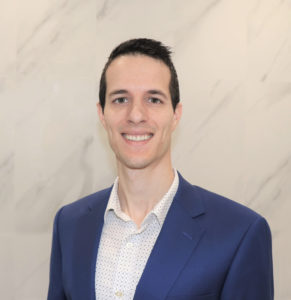 Brandon Sutherland earned a BASc in Nanotechnology Engineering from University of Waterloo in 2012, and a PhD in Electrical and Computer Engineering from the Sargent Group at University of Toronto in 2016. Brandon’s research experience spans the discovery and development of new materials for optoelectronic devices, where he has authored 20 scientific publications. In 2017, he was awarded the Governor General Gold Medal in recognition of his research contributions. In 2017, Brandon was one of the founding editors for Joule, a scale-spanning energy research journal—now one of the highest-cited research publications across all sciences. At Joule, Brandon served as chief evaluator for over 1200 technical, economic, and policy research reports; and published 42 editorials and research features. In 2020, Brandon took on a role as the first Executive Director of A3MD, a multi-institutional academic, industrial, and government initiative to accelerate materials discovery using AI and high-throughput experimentation. In 2023, Brandon joined the Acceleration Consortium. As Director, Research Operations, Brandon oversees the research program of a CAD $200 million funded initiative to develop self-driving labs for materials discovery.
Brandon Sutherland earned a BASc in Nanotechnology Engineering from University of Waterloo in 2012, and a PhD in Electrical and Computer Engineering from the Sargent Group at University of Toronto in 2016. Brandon’s research experience spans the discovery and development of new materials for optoelectronic devices, where he has authored 20 scientific publications. In 2017, he was awarded the Governor General Gold Medal in recognition of his research contributions. In 2017, Brandon was one of the founding editors for Joule, a scale-spanning energy research journal—now one of the highest-cited research publications across all sciences. At Joule, Brandon served as chief evaluator for over 1200 technical, economic, and policy research reports; and published 42 editorials and research features. In 2020, Brandon took on a role as the first Executive Director of A3MD, a multi-institutional academic, industrial, and government initiative to accelerate materials discovery using AI and high-throughput experimentation. In 2023, Brandon joined the Acceleration Consortium. As Director, Research Operations, Brandon oversees the research program of a CAD $200 million funded initiative to develop self-driving labs for materials discovery.
 As an architect and designer, Stig Mikkelsen has a broad skill set and is especially recognized for his design achievements in university buildings, laboratory design and transformation of existing building mass – the most sustainable building approach. Recent projects include Ferring Pharmaceuticals new Copenhagen Headquarters, along with Foster + Partner, a 24.000 m2 large research and development center with offices and laboratories for biochemical, biopharmaceutical and advanced cellular research. The building is certified LEED Gold in sustainability. Stig is also responsible for the 24.000 m2 large Steno Diabetes Center Copenhagen, a state-of-the-art life science building and Northern Europe’s largest hospital for prevention and treatment of diabetes. The project was co-financed by the Novo Nordisk Foundation and contains laboratories, treatments areas, health clinics, and rehabilitation clinic, and 4.500 m2 office space for health personnel and public employees. The Laboratory- and Logistics Building, situated at the heritage Bispebjerg Hospital in Copenhagen, is a project, close to Stig’s heart; this modern research building houses 9.500 m2 of advanced laboratories and research facilities. Stig has also designed and built the Systems Biology Building for the Technical University of Denmark, a university building which houses auditoriums, classrooms and laboratory facilities for research and teaching. The laboratories are cleanrooms with a high purity classification, GMO classification, and fulfil containment/biosafety requirements.
As an architect and designer, Stig Mikkelsen has a broad skill set and is especially recognized for his design achievements in university buildings, laboratory design and transformation of existing building mass – the most sustainable building approach. Recent projects include Ferring Pharmaceuticals new Copenhagen Headquarters, along with Foster + Partner, a 24.000 m2 large research and development center with offices and laboratories for biochemical, biopharmaceutical and advanced cellular research. The building is certified LEED Gold in sustainability. Stig is also responsible for the 24.000 m2 large Steno Diabetes Center Copenhagen, a state-of-the-art life science building and Northern Europe’s largest hospital for prevention and treatment of diabetes. The project was co-financed by the Novo Nordisk Foundation and contains laboratories, treatments areas, health clinics, and rehabilitation clinic, and 4.500 m2 office space for health personnel and public employees. The Laboratory- and Logistics Building, situated at the heritage Bispebjerg Hospital in Copenhagen, is a project, close to Stig’s heart; this modern research building houses 9.500 m2 of advanced laboratories and research facilities. Stig has also designed and built the Systems Biology Building for the Technical University of Denmark, a university building which houses auditoriums, classrooms and laboratory facilities for research and teaching. The laboratories are cleanrooms with a high purity classification, GMO classification, and fulfil containment/biosafety requirements.
 Iyonne Rippie is a professional engineer in the United States and Senior Mechanical Consultant in Arup’s Toronto Office with over 35 years of experience in the design of mechanical systems in the built environment across many building sectors. With a passion for bringing energy efficiency and sustainable design to every building, Iyonne has been leading projects in Arup since 2013 and designing mechanical systems in the laboratory built environment since 2000.
Iyonne Rippie is a professional engineer in the United States and Senior Mechanical Consultant in Arup’s Toronto Office with over 35 years of experience in the design of mechanical systems in the built environment across many building sectors. With a passion for bringing energy efficiency and sustainable design to every building, Iyonne has been leading projects in Arup since 2013 and designing mechanical systems in the laboratory built environment since 2000.
Liam Brown is a Nationally licensed Architect and principal at mcCallumSather, leading their Science and Technology team. mcCallumSather is a multidisciplinary firm that delivers Architecture and Mechanical Engineering project solutions that advance sustainability and strive for a more resilient world. Liam is passionate about solving complex problems and working collaboratively throughout the lifespan of any project. Through over ten years of practice, Liam has designed a wide range of project typologies supporting life science research for both private and public sectors.
Liam’s list of past and current clients includes the University of Waterloo, University of Toronto, University of Guelph, Conestoga College, Life Labs, Biovectra, DeNova, McMaster University, Ontario Power Generation/Laurentis, McMaster Innovation Park, Geneseeq Technologies, and OmniaBio/CCRM.
 An Associate Principal at Cumulus Architects, Amanda Fics is a proven leader managing projects in the life sciences, innovative healthcare and post secondary education. She has worked on large-scale developments, integrated master plans, complex renovations and P3 pursuits. Deeply passionate about ensuring the design process is informed through engagement – Amanda has established a reputation for balancing the diverse interests of stakeholders and user groups, managing client requirements, and maximizing the impact of large consultant teams. Over the past year Amanda has worked as project manager for the Lash Miller Chemistry Building Expansion Project, coordinating all aspects of technical design and delivery.
An Associate Principal at Cumulus Architects, Amanda Fics is a proven leader managing projects in the life sciences, innovative healthcare and post secondary education. She has worked on large-scale developments, integrated master plans, complex renovations and P3 pursuits. Deeply passionate about ensuring the design process is informed through engagement – Amanda has established a reputation for balancing the diverse interests of stakeholders and user groups, managing client requirements, and maximizing the impact of large consultant teams. Over the past year Amanda has worked as project manager for the Lash Miller Chemistry Building Expansion Project, coordinating all aspects of technical design and delivery.
Sustainability and Digitalization: Meeting the Challenges of a Changing Research Workplace
Durabilité et numérisation : relever les défis d’un milieu de travail de recherche en évolution
Luke Hancox, Siemens
The objective of this presentation is to introduce attendees to a slate of emerging technologies and techniques that can reduce laboratory energy consumption and carbon footprint safely and sustainably.
L’objectif de cette présentation est de présenter aux participants une liste de technologies et de techniques émergentes qui peuvent réduire la consommation d’énergie des laboratoires et l’empreinte carbone de manière sûre et durable.
Decarbonization is now a must-do for all organizations, and with more than 61 million Gen Zers making up one-fifth of the workforce, the pressure is on for labs to transform their outdated spaces and designs into safe and sustainable environments that are as smart as the people using them. Unfortunately, many of today’s labs continue to rely on outdated practices and technology. Attendees of this session will learn how to apply a risk-based approach to assess and develop safer, more cost-effective, and less carbon-intensive lab facilities.
IoT-based methodologies can intelligently combine the control and management of heating, cooling, ventilation, containment, lighting, and daylighting into a single platform to provide greater occupant comfort, workspace flexibility, lab safety and performance. Monitoring and assessing data analytics for labs provides visibility into performance thereby optimizing operations, reducing downtime, and contributing to safety and compliance efforts alongside a reduction in energy consumption.
While electrification can reduce a lab’s carbon footprint, it often involves a large capital expense. Optimizing the HVAC system as much as possible before undertaking electrification can not only reduce operating costs and carbon emissions earlier but can also reduce the capital cost required to electrify the building and take the final step in the decarbonization journey.
La décarbonisation est maintenant un besoin impératif pour toutes les organisations, et avec plus de 61 millions d’ouvriers de la Génération Z représentant un cinquième de la main-d’œuvre, la pression est sur les laboratoires pour transformer leurs espaces et conceptions obsolètes en environnements sûrs et durables qui sont aussi intelligents que les personnes qui les utilisent. Malheureusement, de nombreux laboratoires d’aujourd’hui continuent de s’appuyer sur des pratiques et des technologies obsolètes. Les participants à cette séance apprendront comment appliquer une approche fondée sur les risques pour évaluer et développer des installations de laboratoire plus sûres et plus rentables, tout en réduisant les émissions de gazes à effet de serre (GES).
Les méthodologies basées sur « l’internet d’objets » peuvent combiner intelligemment le contrôle et la gestion du chauffage, du refroidissement, de la ventilation, du confinement, de l’éclairage et de la lumière du jour en une seule plateforme pour offrir une amélioration de confort aux occupants, de flexibilité de l’espace de travail, de sécurité et des performances du laboratoire. La surveillance et l’évaluation des données récoltés du système de contrôle des laboratoires offrent une visibilité sur les performances, optimisant ainsi les opérations, réduisant les temps d’arrêt et contribuant aux efforts de sécurité et de conformité tout en réduisant la consommation d’énergie.
Bien que l’électrification puisse réduire l’empreinte carbone d’un laboratoire, elle implique souvent des dépenses en capital importantes. L’optimisation du système CVCA autant que possible avant d’entreprendre l’électrification peut non seulement réduire les coûts d’exploitation et les émissions de carbone plus tôt, mais peut également réduire le coût en capital requis pour électrifier le bâtiment et franchir la dernière étape du processus de décarbonisation.
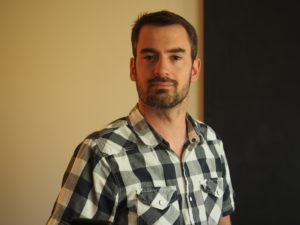 Luke Hancox, P.Eng, received a Bachelor of Engineering (Mechanical) from Memorial University of Newfoundland in 2014 and has worked with Siemens in the field of building technologies since 2016. First as a building automation systems designer, then as an energy service engineer, Luke has experience with building automation technologies and HVAC systems operation and has been involved with a variety of automation and energy conservation projects in life sciences and healthcare facilities.
Luke Hancox, P.Eng, received a Bachelor of Engineering (Mechanical) from Memorial University of Newfoundland in 2014 and has worked with Siemens in the field of building technologies since 2016. First as a building automation systems designer, then as an energy service engineer, Luke has experience with building automation technologies and HVAC systems operation and has been involved with a variety of automation and energy conservation projects in life sciences and healthcare facilities.
Luke Hancox P.Eng a obtenu un baccalauréat en génie (mécanique) de l’Université Memorial de Terre-Neuve en 2014 et travaille avec Siemens dans le domaine des technologies du bâtiment depuis 2016. D’abord en tant que concepteur de systèmes d’automatisation des bâtiments, puis en tant qu’ingénieur des services énergétiques, Luke a de l’expérience avec les technologies d’automatisation des bâtiments et l’exploitation de systèmes CVC et a été impliqué dans une variété de projets d’automatisation et de conservation de l’énergie dans les sciences de la vie et les établissements de santé.
Commissioning for Climate Resiliency
John Bell, RWDI
The objective of this presentation is to discuss the laboratory commissioning process and its effect on climate resiliency n.
In this presentation, the laboratory commissioning process and its effect on climate resiliency will be explored. The importance of performance testing for any lab cannot be understated, and this is even more true with added pressures of a changing climate that brings thermal stress, poor air quality and increased severity of storms. As building systems and decisions become more complicated and integrated, there is greater importance on modernizing how we use data to help provide comprehensive insights. This presentation will share real-world lessons learned on delivering high-performance, climate-ready spaces over the long term.
 John Bell is RWDI’s Technical Director of Commissioning and helps new and existing buildings achieve their full potential. John is an award-winning building commissioning professional with nearly 20 years of testing and commissioning experience and hundreds of projects across diverse sectors and industries, including laboratories and data centers.
John Bell is RWDI’s Technical Director of Commissioning and helps new and existing buildings achieve their full potential. John is an award-winning building commissioning professional with nearly 20 years of testing and commissioning experience and hundreds of projects across diverse sectors and industries, including laboratories and data centers.
Toronto Western Hospital Wastewater Energy Transfer Project
Ian McDermott, University Health Network
The objective of this presentation is to show how the Wastewater Energy Transfer system is able to help the Toronto Western campus move towards net zero. By using the thermal energy of urban wastewater systems, we will have a more reliable and less expensive thermal energy source for our research building.
Every day we are faced with the devastating consequences of global warming, and we don’t have to look outside of Canada to see it. It is constantly in the news and it is impacting us all. From raging forest fires to unseasonable temperature fluctuations, and “100 year storms” that seem to happen annually, we are paying for the consequences of fossil fuel reliance. While some of these terrible events may not impact you, everyone is impacted by skyrocketing utility costs and direct impact to consumers cost of goods. We all must do our part, big and small. The University Health Network (UHN) takes our stewardship responsibilities very seriously and we are thrilled to be able to say that UHN is the first hospital to move forward with the utilization of a Wastewater Energy Transfer (WET) system, implementing this in partnership with Noventa Energy. This unique opportunity at UHN’s Toronto Western campus, which includes our Krembil Discovery Tower, is an exciting project that is well underway towards reducing our campus greenhouse emissions by 50%. This project will improve resiliency, increase our campus heating and cooling capacity, improve our campus redundancy, reduce our greenhouse gas production, reduce our maintenance and capital replacement costs, and save us operational dollars. This presentation will share the excitement and goals of this amazing project.
 Ian McDermott is the Executive Director, Redevelopment and Chief Planning Officer, FM-PRO, University Health Network in Toronto, Ontario. In his current roles, Ian works with clinicians, service providers, design teams, constructors and all levels of government in managing and creating innovative environments for clinical and academic healthcare, research and education. Ian and his team are project, space and clinical/scientific interpreters, translating needs and concepts between the all the users and the design/operational teams.
Ian McDermott is the Executive Director, Redevelopment and Chief Planning Officer, FM-PRO, University Health Network in Toronto, Ontario. In his current roles, Ian works with clinicians, service providers, design teams, constructors and all levels of government in managing and creating innovative environments for clinical and academic healthcare, research and education. Ian and his team are project, space and clinical/scientific interpreters, translating needs and concepts between the all the users and the design/operational teams.
Ian was a founding member of the SLCan Board of Directors and the 2nd President, holding that position for two terms.
Laboratories Canada Repeatable Lab Design Framework: Design Excellence for Federal Facilities
Cathryn Bjerkelund, Laboratories Canada, Public Services and Procurement Canada
The objective of this presentation is to introduce the Laboratories Canada Repeatable Lab Design Framework approach developed in support of the Treasury Board Secretariat Fixed Asset Review recommendations of transforming the science infrastructure portfolio to be strategic, modern and forward looking so as to position Canadian federal science as an international leader.
Laboratories Canada was announced in Budget 2018 with a vision to create a world-class, national network of collaborative, accessible, and sustainable federal laboratories. Its Long Term Vision and Plan (LTVP) is to balance the rapidly evolving S&T needs with real property opportunities, across Canada, to guide an integrated approach to the design and delivery of a modern federal science facility portfolio fostering collaboration, innovation, and science excellence.
The design of laboratory facilities and infrastructure is a primary driver in achieving impactful scientific advances, such as medical breakthroughs, insights that keep our environment clean, and improvements to the health and well-being of Canadians and the environment. Recognizing the vital role that science plays in Canadian society, it is crucial to create a high-quality, functional, and sustainable laboratory portfolio to support its science programs. To create laboratory facilities that support innovation and scientific advancement, while also being sustainable and functional, a repeatable planning and design process is necessary. This repeatable planning and design process can provide outcomes that align with the principles of operating and maintaining a high-quality, high performance laboratory infrastructure efficiently and effectively.
The Repeatable Laboratory Design Framework (RLDF) is a first of its kind compendium of standards, guidelines and best practices to enable consistency and quality assurance across projects by providing a roadmap for design and construction firms to meet design, life cycle, and operational objectives related to sustainability, carbon neutrality, universal accessibility, employee health and safety, interdisciplinary cross-collaboration and flexibility.
Cathryn Bjerkelund is a Senior Director for Laboratories Canada, a partnership between Innovation, Science and Economic Development Canada and Public Services and Procurement Canada (PSPC). The program is a long-term strategy to strengthen federal science by investing in leading edge research facilities across the country. The goal of the strategy is to replace outdated federal laboratories and equip federal scientists with the modern facilities and tools they need to collaborate more effectively with their partners, including academia and the private sector.
Cathryn leads a team of scientists, architects and engineers involved in the development of a design quality framework to guide contracted Architectural and Engineering design teams in developing laboratory infrastructure design solutions to advance modern, collaborative and sustainable laboratory facilities. This approach ensures that scientists who come from similar disciplines will be able to share the same facilities. The laboratory design quality framework for Laboratories Canada draws on industry best practices to provide design and technical recommendations for the creation of high-performance laboratory buildings.
Walking The Walk: Sustainability and Stewardship at the Atlantic Science Enterprise Centre Project
La marche à suivre : Durabilité et intendance dans le cadre du projet de Centre d’entreprise des sciences de l’Atlantique
Sarah Low1, Mrigesh Roy2, Julia Beresford3
1Diamond Schmitt Architects
2CEL Gruen, Crossey Engineering
3Public Services and Procurement Canada
The objective of this presentation is to provide an understanding of the importance and challenges of a designing a world class research facility targeting zero carbon and net zero energy while also meeting the broader project objectives of inclusion, cultural representation, accessibility and wellness.
The new Atlantic Science Enterprise Centre (ASEC) will be a world class research facility located in Moncton, New Brunswick. It will provide federal scientists and partners with state-of-the-art space and equipment to collaborate on research opportunities, and to understand, protect and sustain Atlantic freshwater and coastal ecosystems. The vision for ASEC is to create an innovation platform that facilitates scientific excellence, fosters partnerships and collaboration and creates opportunities for engagement with local Indigenous groups, the broader local community to contribute to inclusive growth for Canadians.
Laboratories Canada’s new Repeatable Laboratory Design Framework (RLDF) is providing a guide to the design and execution of this project, contributing to Lab Canada’s vision for a world-class national network of modern and multi-purpose federal science and technology laboratories that support collaboration, multidisciplinary research and innovation, and evidence-based decision-making.
Public Services and Procurement Canada (PSPC) has committed to achieving a carbon neutral portfolio by 2050. The ASEC project has a wide range of ambitious sustainability targets in response. These include Zero Carbon and Net-Zero Energy ready, using Laboratories Canada’s Zero Carbon Study tool to guide the process, LEED Platinum certification, and FitWel certification.
Lab buildings in Canada present unique challenges, but with a collaborative team effort, these obstacles can be overcome. Cold climate necessitates energy-efficient heating systems including decarbonization, high performance envelope, and advanced HVAC technologies to achieve ultra-low energy consumption. Water conservation and waste management strategies catering to reuse, and reduction of operational waste. This project also focused on embodied carbon and material selections, and procurement practices which prioritize low-impact alternatives. We will also share our team approach which involves architects, engineers, scientists, and sustainability experts to develop integrated and innovative design solutions. Collaboration fosters the identification and implementation of sustainable technologies, optimized operations, and the development of best practices for sustainable research facilities in Canada. This includes exploring advanced technologies such as intelligent lab systems, adaptive lighting, and energy-efficient ventilation, tailored to the specific requirements of each lab space.
The impact of the ambitious sustainability goals for the project also extends beyond the laboratories themselves and aligns with the broader project objectives to create a unique and forward-looking project. For example, reduction of embodied carbon is achieved through two approaches that also contribute to the facility’s cultural significance and commitment to wellness. The heritage building on the site will be partially retained and incorporated into the new facility in commemoration of its important cultural history, while also contributing to the reduction of embodied carbon by reusing material. A hybrid structure provides concrete where necessary for lab areas, while office and public areas are mass timber. This reduces the embodied carbon by 40% while also creating a healthy work environment and supporting sustainability. The confluence of sustainability goals with the broader objectives of the project has led to a richer and more successful project.
Le nouveau Centre d’entreprise des sciences de l’Atlantique (CESA) sera une bâtiment de recherche de classe mondiale située à Moncton, au Nouveau-Brunswick. Il offrira aux scientifiques fédéraux et à leurs partenaires des locaux et des équipements de pointe pour collaborer à des projets de recherche et pour comprendre, protéger et maintenir les écosystèmes côtiers et d’eau douce de l’Atlantique. La vision de CESA est de créer une plateforme d’innovation qui facilite l’excellence scientifique, encourage les partenariats et la collaboration et crée des opportunités d’engagement avec les groupes indigènes locaux, la communauté locale au sens large, afin de contribuer à une croissance inclusive pour les Canadiens.
Le nouveau “Cadre de conception de laboratoires reproductibles” (CCLR) de Laboratoires Canada sert de guide pour la conception et l’exécution de ce projet, contribuant à la vision de Laboratoires Canada d’un réseau national de classe mondiale de laboratoires scientifiques et technologiques fédéraux modernes et polyvalents qui soutiennent la collaboration, la recherche multidisciplinaire et l’innovation, ainsi que la prise de décisions fondées sur des données probantes.
Services publics et Approvisionnement Canada (SPAC) s’est engagé à atteindre un portefeuille neutre en carbone d’ici 2050. Le projet CESA répond à un large éventail d’objectifs ambitieux en matière de développement durable. Il s’agit notamment d’atteindre l’objectif de zéro carbone et de zéro énergie nette, en utilisant l’outil d’étude de zéro carbone de Lab Canada pour guider le processus, la certification LEED Platine et la certification FitWel. Les bâtiments de laboratoire au Canada présentent des défis uniques, mais avec un effort d’équipe collaboratif, ces obstacles peuvent être surmontés. Le climat froid nécessite des systèmes de chauffage efficaces sur le plan énergétique, y compris la décarbonisation, une enveloppe à haute performance et des technologies de pointe en matière de chauffage, de ventilation et de climatisation, afin d’obtenir une consommation d’énergie très faible. Les stratégies de conservation de l’eau et de gestion des déchets visent la réutilisation et la réduction des déchets d’exploitation. Ce projet s’est également concentré sur le carbone intrinsèque et la sélection des matériaux, ainsi que sur les pratiques d’approvisionnement qui donnent la priorité aux alternatives à faible impact. Nous partagerons également notre approche d’équipe qui implique des architectes, des ingénieurs, des scientifiques et des experts en développement durable pour développer des solutions de conception intégrées et innovantes. La collaboration favorise l’identification et la mise en oeuvre de technologies durables, l’optimisation des opérations et le développement de meilleures pratiques pour des installations de recherche durables au Canada. Cela inclut l’exploration de technologies avancées telles que les systèmes de laboratoire intelligents, l’éclairage adaptatif et la ventilation économe en énergie, adaptés aux exigences spécifiques de chaque espace de laboratoire.
L’impact des objectifs ambitieux de durabilité du projet s’étend également au-delà des laboratoires eux-mêmes et s’aligne sur les objectifs plus larges du projet pour créer un projet unique et tourné vers l’avenir. Par exemple, la réduction du carbone incorporé est obtenue grâce à deux approches qui contribuent également à l’importance culturelle des installations et à l’engagement en faveur du bien-être. Le bâtiment patrimonial du site sera partiellement conservé et intégré à la nouvelle installation en commémoration de son importante histoire culturelle, tout en contribuant à la réduction du carbone incorporé par la réutilisation des matériaux. Une structure hybride prévoit du béton là où c’est nécessaire pour les zones de laboratoire, tandis que les bureaux et les zones publiques sont en bois massif. Cela permet de réduire de 40 % le carbone incorporé, tout en créant un environnement de travail sain et en soutenant la durabilité. La confluence des objectifs de durabilité avec les objectifs plus larges du projet a conduit à un projet plus riche et plus réussi.
 Mrigesh Roy, CEM, CEA, LEED AP BD+C, LEED AP ID+C, RESET AP, BEMP, has over twelve years of experience and specializes in sustainable and high‐performance building design using advanced computation methods. He has been part of teams for many high-profile sustainability projects, including sports facilities, airports, laboratories, universities, multifamily, and commercial offices which are LEED Gold or Platinum certified.
Mrigesh Roy, CEM, CEA, LEED AP BD+C, LEED AP ID+C, RESET AP, BEMP, has over twelve years of experience and specializes in sustainable and high‐performance building design using advanced computation methods. He has been part of teams for many high-profile sustainability projects, including sports facilities, airports, laboratories, universities, multifamily, and commercial offices which are LEED Gold or Platinum certified.
Mrigesh is passionate about sustainability and has dedicated himself to this field, promoting green building strategies by working with communities to reduce carbon emissions and has a well-rounded background which utilizes a collaborative and practical approach to guide project teams to reach their sustainability, health and wellness initiatives.
 Sarah Low, RIBA, LEED AP, has extensive experience in academic and institutional projects, and projects with a strong sustainable design component, targeting LEED Gold and Platinum, Net Zero energy, and Living Building Challenge, and incorporating mass timber, and urban agriculture. She is a LEED Accredited Professional.
Sarah Low, RIBA, LEED AP, has extensive experience in academic and institutional projects, and projects with a strong sustainable design component, targeting LEED Gold and Platinum, Net Zero energy, and Living Building Challenge, and incorporating mass timber, and urban agriculture. She is a LEED Accredited Professional.
Sarah’s architectural work with the firm has focused on the design of complex projects with numerous stakeholders that include academic facilities for universities and colleges including laboratory buildings, classroom and office buildings for arts and science faculties, trades schools, libraries, sports facilities, and an innovation centre. As Project Architect, Sarah’s projects include the Okanagan College Trades Renewal and Expansion Project, which achieved the ambitious sustainability target of Net Zero Energy ready and LEED Platinum; the DARE District project at Algonquin College in Ottawa, a new LEED Gold Innovation Centre which includes a mass timber addition; and, the Social Sciences Building at the University of Ottawa, a LEED Gold 25,000m2, 15-storey new academic building.
Sarah is a team leader who listens carefully and thoughtfully and approaches each project with attention to detail and the inclusion of all voices.
She attended the University of Toronto School of Architecture and went on to complete her education at the Architectural Association School of Architecture in London, England.
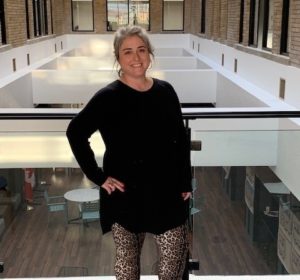 Julia Beresford is a senior environmental specialist with Public Services and Procurement Canada (PSPC) on the Greening and Climate Action teams. She provides advice and guidance on major projects to ensure we meet the Treasury Board Secretariat Greening Government Strategy. She also runs Climate Risk and Vulnerability Studies to feed into design projects and help guide PSPC Asset Management Plans. She has over 14 years experience in sustainability and climate related work.
Julia Beresford is a senior environmental specialist with Public Services and Procurement Canada (PSPC) on the Greening and Climate Action teams. She provides advice and guidance on major projects to ensure we meet the Treasury Board Secretariat Greening Government Strategy. She also runs Climate Risk and Vulnerability Studies to feed into design projects and help guide PSPC Asset Management Plans. She has over 14 years experience in sustainability and climate related work.
Decarbonizing University Campuses and Laboratories
Mary On, Introba
The objective of this presentation is to share how decarbonizing labs depends on master planning for the existing buildings housing them, and the technical options for cost-effectively electrifying at scale, as well as to discuss the role and design of mandatory design requirements and best practice guidelines for lab mechanical systems in new design projects.
Decarbonizing labs requires coordinated action at the campus, building, and lab level – through integrated planning across these scales, reaching carbon neutrality is possible and even cost-effective. Introba and Johns Hopkins University (JHU), one of the world’s leading research universities, partnered on a feasibility study for decarbonizing all university facilities. Two major, interconnected components of the study involved a high-level roadmap of district energy systems and building heating, and the development of potential requirements for high-performance and healthy buildings.
The feasibility study examined a range of technical solutions at the campus level, including heat recovery, air source heat pumps, and geo-exchange systems to electrify all major heating and service hot water system. The solutions were grouped into five technical pathways at varying levels of complexity and cost. This presentation will explore the most effective solutions for decarbonization and the factors that impacted cost-effectiveness.
With thousands of laboratories at JHU, lab buildings represent one of the most energy intensive building types across JHU campuses. A set of potential requirements and best practice guidelines for new laboratory mechanical systems was created to ensure all lab projects are planned and designed to the highest energy performance while being pragmatic and reasonable.
Zero Carbon Design Strategies for the Renovated Lab
Antoni Paleshi, WSP Canada
The objective of this presentation is to review the decarbonized capital planning process in general and how it applies uniquely to laboratory facilities, with specific approaches that attendees can apply to their existing laboratories.
Despite the on-going growth and transformation of laboratory spaces across Canada, reaching zero carbon in our lab infrastructure cannot be done through new construction alone. Existing assets must be transformed too, which can be challenging given the 24/7 operation and critical nature of lab spaces. Designs need to take into account the limitations (and opportunities) of existing mechanical and electrical systems, the performance of existing envelope assemblies and adapt to the available footprint in the building while limiting the construction impact on the researchers that need to continue to use the building.
WSP was engaged on this confidential project to design a zero operational carbon solution for a major laboratory renovation. In this presentation, Antoni will review the drivers and general process of decarbonized capital planning for existing facilities and how this process establishes the goals and drivers for the work at the example renovation. Antoni will also review specific strategies at the facility that were developed to achieve the client’s goals while minimizing the disruption to the ongoing research activities.
Specific concepts that will be reviewed include:
- Key drivers for net zero action in the building sector, with particular focus on public sector owners;
- A systematic approach to decarbonize a long-hold asset, such as a laboratory facility;
- Review of the carbon neutral study process as it applies to existing/renovation lab facilities; and,
- Lab-focused strategies for enclosure, HVAC delivery systems, fuel switching, and on-site power systems.
We will also review how the net zero carbon strategies support and align with broader sustainability goals and other co-benefits to the project, creating a sustainable environment that allows researchers to thrive.
 Antoni Paleshi is a national lead for zero carbon buildings in WSP’s Climate Change, Resilience and Sustainability team, with 19 years of experience in the field. Antoni specializes in the design, simulation and evaluation of building efficiency and GHG reduction strategies with experience leading teams towards zero carbon buildings in all sectors.
Antoni Paleshi is a national lead for zero carbon buildings in WSP’s Climate Change, Resilience and Sustainability team, with 19 years of experience in the field. Antoni specializes in the design, simulation and evaluation of building efficiency and GHG reduction strategies with experience leading teams towards zero carbon buildings in all sectors.
Antoni’s on-going laboratory net zero experience includes work with Laboratories Canada across three sites, three multi-building laboratory projects and a new commercial laboratory project in Vancouver.
Antoni is also lead on several decarbonization strategy projects at the portfolio, campus and community-scale for public and private sector clients across Canada.
Institutional Mass Timber Projects Around the World
The objective of this presentation is to showcase three mass timber projects from academic institutions in Canada, the United States and Spain and engage in a moderated discussion and audience Q&A session
In the words of Winston Churchill, “We shape our buildings; thereafter they shape us.” The Trades and Technology Centre at the British Columbia Institute of Technology (BCIT) is a newly to be constructed facility meant to accommodate six departments. For years, these programs have been housed in various buildings that were adapted to meet their needs. This circumstance has cultivated a distinct culture among the users, influencing the way they deliver their programs to students.
During the programming phase of the project, the new building presented an opportunity to capitalize on the positive aspects of the existing culture, and a necessity to incorporate changes to align with 22nd-century sustainable requirements and pedagogical delivery methods to foster a stronger sense of community and to promote collaboration between departments.
The owner and project team are committed to the delivery of a class leading low carbon building. Through the use of mass timber we are able to achieve this ambition while also unlocking numerous other benefits for both the building, the occupants, the community and the environment. Despite being one of our oldest construction materials, timber continues to be plagued by uncertainties, misunderstandings, and misconceptions. In the world of science and technology, there remain performance concerns of a wood structure. However, driven by accelerating diverse adoption, the maturing mass timber market is rapidly developing new products and solutions to address these concerns in ever more efficient and cost-effective ways. A range of market-ready solutions and modern design options are now available to mitigate these perceived risks, with timber construction risks shown to be not significantly different than those associated with other materials. Yet, beyond these comparisons, there is growing recognition that current metrics for measuring design success are outdated and do not necessarily reflect the values of good design. True sustainability prioritizes the long-term interests of people, the environment, and our communities, and as we begin to quantify the impact of design decisions through wellness, engagement, and decarbonization, it is becoming clear that modern methods of construction and materials, such as mass timber, are ideally positioned to support this journey. By challenging arbitrary design parameters and discarding outdated assumptions, we can fundamentally transform the design process.
In this presentation, the speakers will share the challenges and success stories encountered by the team and the users. They will also highlight the significant impact of collaboration among all stakeholders involved throughout this transformative process, demonstrating how this renewed decision-making process helped unlocked the design potential and thereby highlighting the potential of mass timber to lead the way in sustainable construction.
 William Johnston is an accomplished structural engineer with over 20 years of diverse experience. He currently leads the WSP team in BC, and part of WSP’s global structural leadership team. William chairs WSP’s global mass timber working group, and is a member of the Wood WORKS! BC Governance Committee. He previously led WSP’s Healthcare team in Africa.
William Johnston is an accomplished structural engineer with over 20 years of diverse experience. He currently leads the WSP team in BC, and part of WSP’s global structural leadership team. William chairs WSP’s global mass timber working group, and is a member of the Wood WORKS! BC Governance Committee. He previously led WSP’s Healthcare team in Africa.
William’s global experience extends through Canada, South Africa, United Kingdom, Nigeria, Kenya, and South Sudan. His portfolio is varied, from prestigious towers in London, to Africa’s first “Green” city in Pretoria, to multiple mass timber structures in Vancouver.
 Sarmad Al-Mashta is a Principle Architect at Architecture 49 and an award-winning instructor in the Building Engineering department at Concordia University in Montreal. Sarmad has 28 years of international experience spanning multiple building types and sectors. His current focus is to lead the science and tech project in the Vancouver office. Sarmad firmly believes that architecture is a technology that facilitates life. For him, the built environments inspire human beings and constitute a major factor in their well-being. Guided by this vision, he employs established and emerging technologies as a means to attain excellence and sustainability in the built environment.
Sarmad Al-Mashta is a Principle Architect at Architecture 49 and an award-winning instructor in the Building Engineering department at Concordia University in Montreal. Sarmad has 28 years of international experience spanning multiple building types and sectors. His current focus is to lead the science and tech project in the Vancouver office. Sarmad firmly believes that architecture is a technology that facilitates life. For him, the built environments inspire human beings and constitute a major factor in their well-being. Guided by this vision, he employs established and emerging technologies as a means to attain excellence and sustainability in the built environment.
 Sakshi Misra is an Architect and has been with Architecture 49 for over five years. Her work is focused on the science and technology sector on a wide variety of laboratory typologies. Sakshi is part of national team in A49 team that collaborate with multidisciplinary teams to achieve solutions that correspond to complexities of today’s buildings. Sakshi is involved in 2 major projects and multiple smaller ones including case studies. Sakshi is a pro-active team member who analyzes the complexities of the tasks associated with designing successful solutions.
Sakshi Misra is an Architect and has been with Architecture 49 for over five years. Her work is focused on the science and technology sector on a wide variety of laboratory typologies. Sakshi is part of national team in A49 team that collaborate with multidisciplinary teams to achieve solutions that correspond to complexities of today’s buildings. Sakshi is involved in 2 major projects and multiple smaller ones including case studies. Sakshi is a pro-active team member who analyzes the complexities of the tasks associated with designing successful solutions.
The most recent Intergovernmental Panel on Climate Change (IPCC) report made abundantly clear we need to do everything possible to reduce or eliminate carbon in our built environment. However stark the need – the devil is always in the details – and the implementation of some of our best renewable building materials to lower embodied carbon and create a restorative campus is often met with challenges, doubts and funding issues. This session explores the current challenges surrounding mass timber development including supply chain and schedule risks due to availability, concern for sustainable sourcing, construction industry familiarity, and coordination issues. Through a case study of the visioning and concept design process at the ARS/WSU Plant Biosciences Research Building, we discuss how these potential challenges can be overcome and share some of the strategies used to assure that our best laid plans are carried into further design development phases. Finally, we look at the specific concerns around incorporating mass timber into a lab, with its stringent technical requirements, equipment demands and environmental controls. In addition, the desire for the project to be connected to an existing lab building requires additional considerations. The discussion will include an overview of the federal and specifically USDA regulations that promote the use of mass timber in new buildings.
Tom Knittel is a registered architect in multiple states in the US, a LEED AP BD+C professional Design Principal and is HDR’s global Design Director for Sustainability. He actively leads the design direction of projects and our global efforts on low-carbon solutions, with a special focus on healthcare and science-related facilities. His current mass timber projects utilize a carbon-balancing methodology, targeting net-zero emitted carbon on day-one for structure, core and shell. He is a frequent lecturer on mass timber, embodied carbon, design innovation and the ecologies of place.
 Jing Kong a structural Engineer and a mass timber specialist with over 25 years of experience in the design of complex structures in all materials and over 15 years of specialized expertise in modern timber structures. Jing has recently become an expert in CLT design and contributed to the success of many of largest projects featuring engineered wood in addition to the design of several award-winning mass timber projects in Canada, the United States, and China. He has worked on numerous high-profile and large-scale projects in the institutional, commercial, residential, recreational, and industrial sectors.
Jing Kong a structural Engineer and a mass timber specialist with over 25 years of experience in the design of complex structures in all materials and over 15 years of specialized expertise in modern timber structures. Jing has recently become an expert in CLT design and contributed to the success of many of largest projects featuring engineered wood in addition to the design of several award-winning mass timber projects in Canada, the United States, and China. He has worked on numerous high-profile and large-scale projects in the institutional, commercial, residential, recreational, and industrial sectors.
Envisioned as the new Center of Research for Barcelona’s Universitat Pompei Fabre (UPF), this 14,000 SM project brings together two institutions—UPF and the Institut de Biologia Evolutiva (IB)—to create a hub of knowledge to solve the problems of planetary health. The two buildings have been designed to be net positive (operational and embodied) and will be the first mass timber laboratory buildings in Spain. The project will be “part of the community of Barcelona” rather than just a good neighbor, sited in a park adjacent to the city zoo. These two buildings connect via a “collaboration bridge” which is linked vertically with a signature stair to a roof top garden. The buildings also house a conference center, restaurant, gallery space, and maker space for students, along with highly technical research environments.
 As a ZGF Associate Principal and architect with over 18 years of experience, Lia Peacock has worked with diverse clients on numerous institutional and commercial buildings, specializing in projects that utilize mass timber as a primary construction material. This includes both academic and institutional mass timber laboratories and the mass timber expansion of the Portland International Airport. As a designer, she cares deeply about how architecture can influence our culture and shape our cities. In every project, she explores what is possible and strives for design excellence, approaching each challenge as an opportunity that is unique to the project.
As a ZGF Associate Principal and architect with over 18 years of experience, Lia Peacock has worked with diverse clients on numerous institutional and commercial buildings, specializing in projects that utilize mass timber as a primary construction material. This includes both academic and institutional mass timber laboratories and the mass timber expansion of the Portland International Airport. As a designer, she cares deeply about how architecture can influence our culture and shape our cities. In every project, she explores what is possible and strives for design excellence, approaching each challenge as an opportunity that is unique to the project.
The McGill New Vic Project – Innovative Sustainable Lab Design
Le Nouveau Vic de McGill – Conception de laboratoire innovante et durable
Cecily Eckhardt and Dennis Giobbe
Diamond Schmitt Architects
The objective of this presentation is to showcase this innovative facility designed to promote collaborative multi-disciplinary research focused on sustainability.
L’objectif de cette présentation est de mettre en valeur cette installation innovante conçues pour promouvoir la recherche multidisciplinaire et collaborative axée sur le développement durable.
To tackle one of the world’s most intractable issues, sustainability, McGill University envisions a new type of research facility that connects disciplines from across the arts and sciences. By allowing science and public policy to co-exist, the ambition is to link scientific discovery with policy implementation. The facility, in essence, is a living lab that removes traditional academic barriers and provides the framework for research based on activity rather than academic department.
This collaborative talk will cover the evolution of the design concept for activity-based labs, that are designed to provide robust day one capacity, as well as future growth. Sustainable strategies for the lab design as well as the broader sustainable design strategies will be discussed, including the TCO of sustainable design options for strategic decision making, fume heat recovery, diversity and designing for more generic setups, as well as the building’s energy efficiency targets.
At the outset, Cecily Eckhardt will discuss McGill’s goals to develop research spaces based on activity rather than discipline, and the development of lab typologies and module design. Dennis Giobbe will delve into the details of the lab layouts, integration of modular casework, user group considerations, and the careful coordination with the mechanical and electrical consultants to provide a broad range of top-down services that allow researchers to adapt their research needs.
They will then outline the major sustainability targets for the project and how these were analyzed to determine the best strategies for the project, including Smart glass, optimizing R value performance vs cost, triple glazing vs double glazing, optimizing window orientation, heat recovery, wet Lab system, dry lab system, fresh air management and reduction, VA systems, analysis of air quality monitoring system, low flow fume hoods, solar wall, natural ventilation, photovoltaic solar panels, magnetic chillers, geothermal wells and heat pumps (900 tons), thermal storage with phase change systems. Turning to a focus on the labs, the talk will review the challenge in managing a high fume hood density demand for 220 fumes hoods, diversity of 70% for fume hood use at system level, diversity of 100% for fume hoods for each lab, venturi valves with high speed actuators, as well as the design of fume hoods at 80 FPM but with plan to operate at 60 FPM, ACH 8 occupied at 10 ft ; 6 at 13.5 ft , 4 ACH unoccupied, generic lab services for electrical, gases and capture arm and exhaust connections
Outside the lab, the New Vic will support learning everywhere, through the integration of collaborative informal spaces for interaction and knowledge sharing. Through this, pavilions of the former Royal Victoria hospital are transformed from a former site for medical healing to an intellectual and research site focused on healing the planet.
Pour s’attaquer à l’une des questions les plus épineuses au monde, le développement durable, l’Université McGill propose un nouveau type d’infrastructure de recherche qui met en relation des disciplines des domaines des arts et des sciences. En permettant aux sciences et aux politiques publiques de collaborer, l’objectif est d’associer la découverte scientifique à l’adoption des politiques. Ce laboratoire vivant élimine les barrières académiques traditionnelles et fournit un cadre de recherche basé sur l’activité plutôt que sur le département académique.
Cette présentation collaborative portera sur l’évolution du concept des laboratoires basés sur l’activité, qui sont conçus pour être robustes dès le premier jour et pour offrir une possibilité de croissance future. Les stratégies de développement durable, incluant celles pour la conception des laboratoires, seront discutées, y compris le coût du cycle de vie (TCO) des options de conception durable pour la prise de décisions stratégiques, la récupération d’énergie sur l’évacuation des laboratoires, la diversité et la conception des configurations plus génériques et les objectifs d’efficacité énergétique du bâtiment. Les concepteurs en architecture et l’ingénieur principal en mécanique participeront à la présentation.
Tout d’abord, Cecily Eckhardt discutera des objectifs de McGill pour développer des espaces de recherche basés sur l’activité plutôt que sur la discipline ainsi que du développement des typologies de laboratoires et la conception de modules. Dennis Giobbe se penchera sur les détails de l’aménagement des laboratoires, l’intégration des meubles modulaires, les considérations relatives aux groupes d’usagers et la coordination minutieuse avec les consultants en mécanique et en électricité afin de fournir une variété de services de laboratoire pour alimentation par le plafond permettant aux chercheurs d’adapter les espaces aux besoins de leurs recherches.
Ils présentera les principaux objectifs de développement durable du projet et la manière dont ils ont été analysés pour déterminer les meilleures stratégies pour le projet, y compris le verre intelligent, l’optimisation de sa résistance thermique par rapport au coût, le triple vitrage par rapport au double vitrage, l’optimisation de l’orientation des fenêtres, la récupération de chaleur, le système de laboratoire humide, le système de laboratoire sec, la gestion et la réduction de l’air frais, les systèmes d’air variable, l’analyse du système de contrôle de la qualité de l’air, les hottes à faible débit, le mur solaire, la ventilation naturelle, les panneaux solaires photovoltaïques, les refroidisseurs magnétiques, les puits géothermiques et les pompes à chaleur (900 tonnes), les systèmes de stockage d’énergie thermique à changement de phase. Orienté sur l’opération des laboratoires, la présentation passera en revue les défis de la gestion d’une demande élevée de 220 hottes de laboratoire, la diversité de l’utilisation des hottes au niveau du dimensionnement des systèmes, la diversité des hottes pour chaque laboratoire, les valves venturi avec des actuateurs à haute vitesse, ainsi que la conception de hottes à 80 ppm à la face avec un plan de fonctionnement à un plus bas débit de 60 ppm, le CAH pour des laboratoires en mode occupé, le CAH lorsque les laboratoires sont inoccupés, les services génériques de laboratoire pour l’électricité, les gaz de laboratoires, les bras de capture et les connexions d’échappement.
À l’extérieur des laboratoires, le Nouveau Vic favorisera l’apprentissage en tout lieu, grâce à l’intégration d’espaces collaboratifs informels pour les interactions et le partage des connaissances. Grâce à cela, les pavillons de l’ancien hôpital Royal Victoria passeront d’un ancien site de guérison médicale à un site scientifique axé sur la guérison de la planète.
 Cecily Eckhardt, MArch, OAA, MRAIC, LEED GA, CPHD, practices architecture with the conviction that good design can facilitate positive change, taking on complex projects that challenge convention and set new benchmarks. She embraces design from the early programming and schematic phases through construction, seeking to keep the big ideas at play through the careful execution of the design details.
Cecily Eckhardt, MArch, OAA, MRAIC, LEED GA, CPHD, practices architecture with the conviction that good design can facilitate positive change, taking on complex projects that challenge convention and set new benchmarks. She embraces design from the early programming and schematic phases through construction, seeking to keep the big ideas at play through the careful execution of the design details.
Cecily has contributed to a number of innovative projects, including the LEED Platinum certified canmetMATERIALS Technology Laboratory at McMaster Innovation Park; the Public Health Ontario laboratories at MaRs; the Laboratory Modernization for Environment and Climate Change Canada at the Canada Centre for Inland Waters, the New Vic Project at McGill University. She is the lab design architect for the New Temerity Medical School at UofT, and project manager for TMU’s new School of Medicine.
A graduate of McGill University, Cecily holds a Master of Architecture from the University of Toronto and a Master of Social Science from the London School of Economics and Political Science.
Cecily Eckhardt, MArch, OAA, MRAIC, LEED GA, CPHD, exerce l’architecture avec la conviction qu’une bonne conception peut favoriser un changement positif, tout en entreprenant des projets complexes qui remettent en question les conventions et établissent de nouvelles bases. Elle se consacre à la conception dès les premières phases de programmation et de schématisation, et ce, jusqu’à la construction, cherchant à conserver les grandes orientations grâce à la mise en oeuvre minutieuse des détails de la conception.
Cecily a contribué à de nombreux projets novateurs, incluant le laboratoire technologique CanmetMATÉRIAUX, certifié LEED Platine, situé dans le McMaster Innovation Park, les laboratoires de Santé publique Ontario au centre MaRS, la modernisation du laboratoire au Centre canadien des eaux intérieures pour Environnement et Changement climatique Canada et le projet du Nouveau Vic de l’Université McGill. Elle agit à titre d’architecte pour la conception des laboratoires de la nouvelle faculté de médecine Temerity de l’Université de Toronto et de chargée de projet pour la nouvelle école de médecine de l’Université métropolitaine de Toronto.
Diplômée de l’Université McGill, Cecily est titulaire d’une maîtrise en architecture de l’Université de Toronto et d’une maîtrise en sciences sociales de la London School of Economics and Political Science.
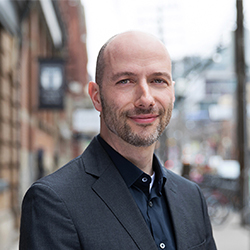 Dennis Giobbe, OAA, LEED AP, is an accomplished Senior Associate with a proven track record of success. He holds degrees from Toronto Metropolitan University and the Pratt Institute in Brooklyn, New York. Since joining Diamond Schmitt Architects in 2003, Dennis has been involved in numerous technically complex projects, serving clients in the academic, healthcare, and public sectors. He has expertise in all phases of project development and is dedicated to establishing strong relationships with contractors to ensure that the design visions are transformed into reality.
Dennis Giobbe, OAA, LEED AP, is an accomplished Senior Associate with a proven track record of success. He holds degrees from Toronto Metropolitan University and the Pratt Institute in Brooklyn, New York. Since joining Diamond Schmitt Architects in 2003, Dennis has been involved in numerous technically complex projects, serving clients in the academic, healthcare, and public sectors. He has expertise in all phases of project development and is dedicated to establishing strong relationships with contractors to ensure that the design visions are transformed into reality.
Dennis’s notable accomplishments include his role as Project Architect for the recently completed Biosciences Renewal Project at the University of British Columbia, where he led a team to deliver a state-of-the-art facility. He also played a key role in the design of the labs for the McGill New Vic Project, utilizing his deep understanding of technical requirements to deliver exceptional outcomes.
McGill University’s CERC Pain Genetic Centre – Building New Labs in Aging Facilities
Université McGill CERC-Centre de recherche de génétique de la douleur – Construire de nouveaux laboratoires dans des installations vieillissantes
Yvon Lachance1 and Magali Tremblay2
1YLA Architecture inc.
2Pageau Morel et associés
The objective of this presentation is to demonstrate how state of the art laboratories can be implemented in aging, mid-century facilities without losing focus on sustainability.
Faced with an aging building stock, increasingly demanding functional and technical programmes and the evolution of research, the trend has been to demolish old laboratories deemed too complex to retrofit and replace them with new, modern, and flexible facilities. However, on the path to decarbonizing and net zero, the conservation and re-use of buildings is proving to be a most effective and sustainable strategy, diverting tonnes of waste from landfills, thus avoiding a senseless dilapidation of resources.
At the 2022 SLCan Sustainable Laboratory Conference, the speakers presented their electro-mechanical equipment replacement project at McGill University’s Lyman-Duff Building, claiming that this extended the building’s useful life by 30 years while allowing for easier future lab renovations. This year, they will present the result of one such contemporary design project: the new Alan Edwards Centre for Research on Pain (AECRP).
The project stems from McGill’s desire to bring together researchers from different disciplines all related to pain research in one place. In addition to areas dedicated to fundamental research, the 1,610 m2 programme includes offices, administrative spaces, individual workstations distributed throughout the facility allowing students to work outside the laboratories, and a multifunctional conference room for meetings and knowledge dissemination.
To host the program, the three lower levels of the “New” (1965) wing of the Duff underwent a major renovation. The previously completed change of the building’s ventilation and electrical systems opened the opportunity to use these obsolete and non-suitable spaces. In anticipation of the future needs of research, laboratory spaces are designed to achieve Bio-Containment Level 2.
Laboratory windows were replaced by sealed units, while those on the south facade overlooking the inner courtyard were enlarged and replaced by curtain walls maximizing supply of natural light in the premises. A new, playful spiral staircase links the two main laboratory levels, encouraging collegiality between users, and the sharing of knowledge and idea.
A methodical approach to analyzing the flow of activities has resulted in a compact, efficient, and safe layout. It is estimated that the laboratory space was reduced by 10% compared to a traditional layout, translating directly into a reduction in the laboratory’s energy and environmental footprint.
The designers’ efforts have paid off. Users are delighted with the result, and the project has been awarded LEED Gold certification. This success is testament to the way in which this modern research centre combines innovation, collaboration, and sustainability. LEED Gold certification recognises the exceptional efforts of the project’s architects, engineers, and stakeholders to create healthy, efficient, low-carbon and low-cost green buildings as part of the refurbishment of an occupied existing building.
The speakers will also present the challenges they faced and the risks such a project is facing, from the initial planning to the implementation. With this conference, they hope to provide participants with tools and keys that will enable them to analyze the feasibility of their project and ensure its success.
Confrontés à un parc immobilier vieillissant, à des programmes fonctionnels et techniques de plus en plus exigeants et face à l’évolution de la recherche, la tendance était de démolir les anciens laboratoires jugés trop complexes à moderniser et de les remplacer par de nouvelles installations modernes et flexibles. Cependant, sur la voie de la décarbonation et du zéro net, la conservation et la réutilisation des bâtiments s’avèrent être des stratégies des plus efficaces et durables, détournant des tonnes de déchets des décharges, évitant ainsi une dilapidation insensée des ressources.
Lors du congrès SLCan 2022, les conférenciers ont présenté leur projet de remplacement d’équipement électromécanique au pavillon Lyman-Duff de l’Université McGill, affirmant que la durée de vie utile du bâtiment serait prolongée de 30 ans tout en facilitant les rénovations futures des laboratoires. Cette année, ils présenteront le résultat d’un tel projet de design contemporain : le nouveau Centre Alan Edwards de recherche sur la douleur (AECRP).
Le projet émane de la volonté de McGill de réunir en un même lieu des chercheurs de différentes disciplines liées à la recherche sur la douleur. Outre les espaces dédiés à la recherche fondamentale, le programme de 1 610 m² comprend des bureaux, des espaces administratifs, des postes de travail individuels répartis dans l’ensemble de l’établissement permettant aux étudiants de travailler en dehors des laboratoires, et une salle de conférence multifonctionnelle pour les réunions et la diffusion des connaissances.
Pour recevoir ce programme, les trois niveaux inférieurs de l’aile “nouvelle” (1965) du Duff ont fait l’objet d’une rénovation majeure. Le changement des systèmes de ventilation et d’électricité du bâtiment, déjà réalisé, a permis d’utiliser ces espaces obsolètes et inadaptés. En prévision des besoins futurs de la recherche, les espaces de laboratoire sont conçus pour atteindre le niveau 2 de confinement biologique.
Les fenêtres des laboratoires côté nord ont été remplacées par des fenêtres à vitrage isolant, tandis que celles de la façade sud donnant sur la cour intérieure ont été agrandies et remplacées par des murs-rideaux maximisant l’apport de lumière naturelle dans les locaux. Un nouvel escalier en colimaçon, ludique, relie les deux principaux niveaux du laboratoire, favorisant la collégialité entre les utilisateurs, le partage des savoirs et des idées.
Une approche méthodique de l’analyse du flux d’activités a abouti à un aménagement compact, efficace et sécuritaire. On estime que l’espace du laboratoire a été réduit de 10% par rapport à un aménagement traditionnel, se traduisant directement par une réduction de l’empreinte énergétique et environnementale des installations.
Les efforts des concepteurs ont porté fruits. Les utilisateurs sont ravis du résultat et le projet a reçu la certification LEED Or Ce succès témoigne de la manière dont ce centre de recherche moderne allie innovation, collaboration et durabilité. La certification LEED Or reconnaît les efforts exceptionnels des architectes, des ingénieurs et des parties prenantes du projet pour créer des bâtiments écologiques sains, efficaces, à faible émission de carbone et peu coûteux dans le contexte de la rénovation d’un bâtiment existant occupé.
Les conférenciers présenteront également les défis auxquels ils ont été confrontés et les risques auxquels un tel projet fait face, de la planification initiale à la mise en œuvre. Avec cette conférence, ils espèrent apporter aux participants des outils et des clés qui leur permettront d’analyser la faisabilité de leur projet et d’en assurer le succès.
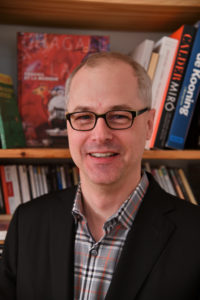 Now heading YLA Architecture, Yvon Lachance boasts nearly 30 years of practice in architecture. He has extensive experience in the realization of large-scale and complex projects. His portfolio of projects includes major institutional and public buildings, university pavilions, research centres (health, chemistry, physics) as well as contemporary and heritage building envelope renovation projects. He is a Fellow of Construction Specification Canada, a member of the International Association for Preservation and its Techniques, a member of the International Institute for Sustainable Laboratories (I²SL), and he is the Immediate Past President of Sustainable Labs Canada.
Now heading YLA Architecture, Yvon Lachance boasts nearly 30 years of practice in architecture. He has extensive experience in the realization of large-scale and complex projects. His portfolio of projects includes major institutional and public buildings, university pavilions, research centres (health, chemistry, physics) as well as contemporary and heritage building envelope renovation projects. He is a Fellow of Construction Specification Canada, a member of the International Association for Preservation and its Techniques, a member of the International Institute for Sustainable Laboratories (I²SL), and he is the Immediate Past President of Sustainable Labs Canada.
Aujourd’hui à la tête de YLA Architecture, Yvon Lachance compte près de 30 ans de pratique en architecture. Il possède une vaste expérience dans la réalisation de projets complexes et d’envergure. Son portfolio de projets comprend d’importants bâtiments institutionnels et publics, des pavillons universitaires, des centres de recherche (santé, chimie, physique) ainsi que des projets de rénovation d’enveloppes de bâtiments contemporains et patrimoniaux. Il est Fellows et 4e Vice-président de Devis de construction Canada, de l’Association internationale pour la préservation et ses techniques, de l’International Institute for Sustainable Laboratories (I²SL) et président sortant de Laboratoires Écologiques du Canada.
Magali Tremblay, P. Eng., is Assistant Director and Associate at Pageau Morel, a consulting engineering firm specialized in the fields of mechanical and electrical engineering, energy efficiency and eco-design. Specializing in laboratories for over 15 years, she has been contributing to many institutional and research centre projects. Magali obtained a Bachelor’s Degree in Electrical Engineering and is also a certified LEED AP. She holds the title of treasurer for the Montreal Chapter of Sustainable Labs Canada (SLCan) as well as been involved in Construction Specification Canada (CSC).
Magali Tremblay est directrice adjointe et associée chez Pageau Morel, une firme de génie-conseil spécialisée dans les domaines du génie mécanique et électrique, de l’efficacité énergétique et de l’écoconception. Spécialisée dans les laboratoires depuis plus de 15 ans, elle a contribué à de nombreux projets institutionnels et centres de recherche. Magali a obtenu un baccalauréat en génie électrique et est également certifiée LEED AP. Elle est la trésorière et vice-présidente de la section montréalaise de Laboratoires Écologiques du Canada (LÉCan-SLCan) et est la présidente de la section montréalaise de Devis de construction Canada (DCC-CSC).
Roadmap to a Laboratories Canada, Net Zero Lab through a Holistic High Performance Whole Building Life Cycle Based Strategy
Martin Mihowich, Laboratories Canada / Laboratoires Canada
Public Services and Procurement Canada / Services publics et Approvisionnement Canada
The objective of this presentation is to demonstrate a high-performance lab design solution while addressing performance benchmarks, incorporating advanced sustainability and avoiding greenwashing.
The Laboratories Canada strategy is creating world class, innovative and collaborative science research centres across the nation which will position Canada at the forefront of new discoveries, spark innovative ways of doing research and deliver on research priorities for Canadians. The Laboratories Canada Long Term Vision and Plan (LTVP) includes the guiding principles of science excellence, collaboration, diverse and inclusive talent pool, agility and responsiveness, environmental sustainability and responsible public stewardship. Further, Laboratories Canada has embarked upon a challenging mandate to build Zero Carbon, energy efficient and high-performance laboratory infrastructure based on a holistic whole building life cycle evaluation through an integrated and collaborative approach.
Labs are widely known to be a prodigious consumer of energy. On a per square foot basis, labs can consume 5 to 10 times more energy than office buildings. Unlike office buildings, which are typically designed around a ventilation standard of 20 cubic feet per minute (cfm) per person of outside air — equal to about one air change per hour (ACH) or less — lab modules normally require 100% outside air — often at exchange rates between 6 and 15 ACH — to meet the aggressive exhaust requirements of fume hoods. Also, in comparison to other institutional and commercial buildings, laboratories may also have high plug loads that can dominate the energy pie and, from an energy efficiency perspective, these can often be overlooked.
This presentation will provide a holistic overview of the Laboratories Canada approach to a Net Zero Carbon, low energy, high-performance laboratory infrastructure based on an integrated life cycle evaluation. The presentation will also highlight some of the challenges and solutions from a Laboratories Canada perspective. The presentation will then get into specific comparison between three different HVAC options meeting lab conditioning requirements, specifically focussed on zero contamination-based energy recovery solutions. The three scenarios are business as usual, energy efficient and towards zero operational carbon. The parameters explored for comparison include operational energy use, GHG emissions and Utility costs, LCCA demonstrating incremental NPV between business as usual and higher performing options. Energy modelling of these options would be based on IES VE software with system performance metrics being extracted from equipment providers.
 Martin Mihowich is Senior Director for Portfolio Strategy, Laboratories Canada at Public Services and Procurement Canada. He is an experienced operational and planning resource with a demonstrated history of working in the research industry. Experienced in multiorganization scientific facilities, workplace transformation and change management. Skilled in leadership in various settings: research and development, government, strategic planning, cross-functional team leadership, and team building.
Martin Mihowich is Senior Director for Portfolio Strategy, Laboratories Canada at Public Services and Procurement Canada. He is an experienced operational and planning resource with a demonstrated history of working in the research industry. Experienced in multiorganization scientific facilities, workplace transformation and change management. Skilled in leadership in various settings: research and development, government, strategic planning, cross-functional team leadership, and team building.
Martin Mihowich est directeur principal de la stratégie de portefeuille, Laboratoires Canada, au sein de Services publics et Approvisionnement Canada. Il s’agit d’une ressource opérationnelle et de planification expérimentée qui a fait ses preuves dans le secteur de la recherche. Il possède une expérience en matière d’installations scientifiques multiorganisations, de transformation du milieu de travail et de gestion du changement. Il est qualifié en matière de leadership dans divers contextes : recherche et développement, gouvernement, planification stratégique, direction d’équipes interfonctionnelles et constitution d’équipes.
Making Informed Decisions for Managing the Transport of Airborne Pathogens while Achieving Energy Use Reductions
Prendre des décisions informées pour gérer le déplacement des pathogènes aérien tout en réduisant la consommation d’énergie
Dianthé van Weerden, RWDI
The objective of this presentation is to provide knowledge and tools that can be used to optimize building ventilation systems for both safety and sustainability.
The COVID-19 pandemic did much to raise awareness about the quality of the air we breathe. Occupants and researchers in lab spaces need assurance that the air they breathe is healthy and clean. Simultaneously, concerns about the changing climate are prompting a strong push for decarbonization and a reduction in energy usage. As a result, the casual implementation of standard ventilation systems in labs may no longer be applicable, and thoughtful ventilation design will be the key to simultaneously achieving both safety and sustainability goals. The type of ventilation system in labs plays an important role in preventing the transmission of airborne pathogens and ensuring adequate distribution of supply air at lower air change rates.
This presentation will give the audience a better understanding of ventilation strategies, the use of computational fluid dynamics (CFD) as a design tool, and the impact of varying ventilation strategies on the dosage of pathogens occupants are exposed to as well as occupant comfort.
La pandémie de COVID-19 a eu l’effet de nous sensibiliser à la qualité de l’air qu’on respire. Les occupants et les chercheurs de laboratoire doivent avoir l’assurance que l’air qu’ils respirent soit sain et propre. Simultanément, les préoccupations concernant le changement climatique incitent une forte poussée en faveur de la décarbonation et à une réduction de la consommation d’énergie. En conséquence, la mise en œuvre désinvolte de systèmes de ventilation ordinaire dans les laboratoires n’est peut-être plus applicable, et la conception systèmes de ventilation réfléchie sera la clé pour atteindre simultanément les objectifs de sureté et de durabilité. Le type de système de ventilation dans les laboratoires joue un rôle important dans la prévention de la transmission de pathogènes aériens et assure une distribution adéquate de l’air d’alimentation à des taux de renouvellement d’air inférieurs.
Cette présentation permettra au public de mieux comprendre les stratégies de ventilation, l’utilisation de la mécanique des fluides numérique (MFN) comme outil de conception et l’impact de différentes stratégies de ventilation sur le dosage des pathogènes auxquels les occupants sont exposés ainsi que sur leur confort.
Dianthé van Weerden is a member of RWDI’s Building Performance Group, providing clients with solutions for issues related to internal ventilation, external building aerodynamics and wind-driven rain. Clients benefit from her broad technical skills, enthusiasm for problem-solving and her ability to see the bigger picture and present complex mitigation concepts in practical terms. She has worked on a variety of interesting projects and developments around the globe, including labs, vivariums, high-performance warehouses, indoor waterparks, and other specialized indoor environments.
No One Left Behind: A Portfolio Data Layer Approach to Net Zero
Personne n’est laissé pour compte : Une approche de la couche de données du portefeuille pour la carboneutralité
Martin Mihowich, Laboratories Canada / Laboratoires Canada
Public Services and Procurement Canada / Services publics et Approvisionnement Canada
The objective of this presentation is to introduce a holistic and systematic data layer approach for development of enterprise science infrastructure recommendations.
L’objectif de cette présentation est d’introduire une approche holistique et systématique de la couche de données pour le développement des recommandations relatives à l’infrastructure scientifique de l’entreprise.
Laboratories Canada is developing a portfolio strategy for federal Science and Technology (S&T) assets, built upon on a systematic and holistic process for whole portfolio analysis. By collecting and evaluating key performance indicators developed specifically for science spaces across all assets in a portfolio, this approach enables evidence-based decision-making, increasing transparency and opportunities for collaboration through comprehensive investment planning. Maximizing value and minimizing waste across assets promotes a leaner, more efficient portfolio that will enable footprint and carbon reductions not accessible at the single asset level.
The presentation will introduce a complete group of S&T data layers, explain the data layer collection and evaluation processes, and provide examples on how the data layers and portfolio process can be leveraged to create long-term plans for achieving a Net Zero portfolio. These are available to all science infrastructure operators and planners.
For application within the federal government, key elements have been designed to simplify assessment in line with the Treasury Board Secretariat Management Accountability Framework and Horizontal Fixed Asset Review recommendations. However, Laboratories Canada has developed this strategy and supporting tools for use by any organization to support evidence-based planning for S&T assets. Coordination across the public and private sectors will help build strong, integrated cases for future infrastructure funding, and better position portfolio planners to coordinate their planning expertise to forecast, scope out, and incorporate emerging developments.
Laboratories Canada is developing a portfolio strategy for federal Science and Technology (S&T) assets, built upon on a systematic and holistic process for whole portfolio analysis. By collecting and evaluating key performance indicators developed specifically for science spaces across all assets in a portfolio, this approach enables evidence-based decision-making, increasing transparency and opportunities for collaboration through comprehensive investment planning. Maximizing value and minimizing waste across assets promotes a leaner, more efficient portfolio that will enable footprint and carbon reductions not accessible at the single asset level.
The presentation will introduce a complete group of S&T data layers, explain the data layer collection and evaluation processes, and provide examples on how the data layers and portfolio process can be leveraged to create long-term plans for achieving a Net Zero portfolio. These are available to all science infrastructure operators and planners.
For application within the federal government, key elements have been designed to simplify assessment in line with the Treasury Board Secretariat Management Accountability Framework and Horizontal Fixed Asset Review recommendations. However, Laboratories Canada has developed this strategy and supporting tools for use by any organization to support evidence-based planning for S&T assets. Coordination across the public and private sectors will help build strong, integrated cases for future infrastructure funding, and better position portfolio planners to coordinate their planning expertise to forecast, scope out, and incorporate emerging developments.
 Martin Mihowich is Senior Director for Portfolio Strategy, Laboratories Canada at Public Services and Procurement Canada. He is an experienced operational and planning resource with a demonstrated history of working in the research industry. Experienced in multiorganization scientific facilities, workplace transformation and change management. Skilled in leadership in various settings: research and development, government, strategic planning, cross-functional team leadership, and team building.
Martin Mihowich is Senior Director for Portfolio Strategy, Laboratories Canada at Public Services and Procurement Canada. He is an experienced operational and planning resource with a demonstrated history of working in the research industry. Experienced in multiorganization scientific facilities, workplace transformation and change management. Skilled in leadership in various settings: research and development, government, strategic planning, cross-functional team leadership, and team building.
Martin Mihowich est directeur principal de la stratégie de portefeuille, Laboratoires Canada, au sein de Services publics et Approvisionnement Canada. Il s’agit d’une ressource opérationnelle et de planification expérimentée qui a fait ses preuves dans le secteur de la recherche. Il possède une expérience en matière d’installations scientifiques multiorganisations, de transformation du milieu de travail et de gestion du changement. Il est qualifié en matière de leadership dans divers contextes : recherche et développement, gouvernement, planification stratégique, direction d’équipes interfonctionnelles et constitution d’équipes.
The Pathway to Net Zero in the Intense Laboratories Settings Using AECOM Zero
Leslie Sims, Ryan Meador, Anaëlle Perez
AECOM
The objective of this presentation is to illustrate the critical steps in the design process that will impact how projects are achieving net zero, and carbon neutrality using the AECOM zero database.
Utilizing a proprietary tool, AECOM zero, this session will demonstrate how we have been able to maximize the physical form and shape of the building to reduce energy use. We will demonstrate the design process in developing a laboratory program and the iterations and team effort that resulted in a net zero building using less than 30% renewables.
In addition, we will review the pros and cons of new mechanical technologies that are being employed that save energy and smooth the path to net zero. We will use case studies to illustrate ideas around climate and understanding what various locations can contribute to reaching net zero goals. We will also impart the “all in” attitude required to keep an open mind to new ways of seeing a program develop.
We will also discuss the role that technology is playing for occupants in creating the environment they need and monitoring the success of energy savings.
The case studies will show an evolution from projects that have competed for 5 or more years to how we are approaching the goals of net zero and carbon neutrality.
 Leslie Sims, AIA, NCARB, LEED AP, BD+C, leads the Science and Technology’s global practice for AECOM. She has over 30 years of experience working for research clients for a wide variety of markets such as higher education, corporate, and government. She brings a wealth of experience to clients and facilitates a consensus basis process to develop programs and designs to realize the project goals.
Leslie Sims, AIA, NCARB, LEED AP, BD+C, leads the Science and Technology’s global practice for AECOM. She has over 30 years of experience working for research clients for a wide variety of markets such as higher education, corporate, and government. She brings a wealth of experience to clients and facilitates a consensus basis process to develop programs and designs to realize the project goals.
 Anaëlle Perez has 23 years of experience and dedicated the last 17 years of her career working on complex research projects in architectural planning, design, and construction supervision.
Anaëlle Perez has 23 years of experience and dedicated the last 17 years of her career working on complex research projects in architectural planning, design, and construction supervision.
Before joining AECOM, she worked for McGill University and for NFOE architects advocating for a variety of clients including Université de Montréal, McGill University, Concordia University and Royal Vic Hospital, Jewish general and Rosemont Maisonneuve hospitals.
 Ryan Meador, is the Managing Principal of a specialized team of high performance Architects, Engineers, Planners, and Asset Management within AECOM’s West Region. With 20 years experience in laboratory design, dedicated to advancements in energy reduction, he brings a unique perspective from a vast portfolio of private and public clientèle.
Ryan Meador, is the Managing Principal of a specialized team of high performance Architects, Engineers, Planners, and Asset Management within AECOM’s West Region. With 20 years experience in laboratory design, dedicated to advancements in energy reduction, he brings a unique perspective from a vast portfolio of private and public clientèle.
A Comparison of Three Engagement Programs in the Benchmarking of Sustainable Lab Operations at McGill
Kimberly John and Vibhor Saoji
McGill University
The objective of this presentation is to compare the implementation, results and outcomes of an outsourced lab engagement and benchmarking program with an in-house program for sustainable lab operations at McGill University.
McGill University is working toward two sustainability targets: carbon neutrality by 2040, and to become zero-waste by 2035. As a top research university in Canada and home to more than 470 laboratories, these goals cannot be accomplished without the support of lab users and the integration of lab spaces which account for 17% of total building area but 47% of building energy use.
In May 2022 McGill piloted the My Green Lab® certification program, followed in January 2023 with the launch of university-wide participation in the International Freezer Challenge. Both of these are globally-recognised initiatives from My Green Labs, an international non-profit organisation. The McGill Sustainable Labs Certification program was launched in May 2023 to provide users of research and teaching labs with ways to evaluate their lab practices against clear standards and to set the stage for improvements. While the out-sourced programs provided valuable guidance on sustainable lab operations, the in-house program focussed more on aspects of lab operations that are within local lab users control and that reflect the unique conditions at McGill, while also advancing the University’s sustainability goals.
Collectively the initiatives have reached more than 400 lab users directly and the community is embracing the opportunity to benchmark lab operations against internal and external standards. The Freezer Challenge in particular has also enabled the University to calculate (and clearly communicate) the kwH and CO2 equivalents saved through collective lab behaviours and to compare its performance with hundreds of peer institutions, industrial and other labs worldwide.
The main implementation challenges arise from the disaggregated nature of labs across McGill’s campuses. These have been addressed through the strategic allocation of human and financial resources, careful top-down and bottom-up communications, and by partnering across administrative units.
Now in the second year of implementation, these sustainable lab initiatives have transitioned McGill’s sustainable lab efforts from dissociated individual actions to a more collective movement among the more than 19,000 lab users. They have also increased the prominence of lab sustainability among supporting units such as Environmental Health & Safety, Facilities and Procurement and laid the groundwork for more ambitious sustainable lab projects to deal with lab waste and energy at the institutional level.
 Kimberly John (MPhil Ecology and MSc Bioresource Engineering) is the Sustainability Officer at McGill Office of Sustainability focused on the integration of environmentally responsible practices in laboratories at McGill. Her background is conservation and applied research, and she has several years’ experience in project and program management.
Kimberly John (MPhil Ecology and MSc Bioresource Engineering) is the Sustainability Officer at McGill Office of Sustainability focused on the integration of environmentally responsible practices in laboratories at McGill. Her background is conservation and applied research, and she has several years’ experience in project and program management.
Vibhor Saoji is a Master of Engineering (M.Eng.) student in Civil – Environmental Engineering at McGill University. He has a Bachelor of Science (B.Sc.) degree in Chemical Engineering from SUNY University at Buffalo (2016 – 2020). He is currently a Sustainable Labs Intern at the McGill Office of Sustainability. In this role, he has generated up-to-date lab area and energy use metrics at McGill University, helped to develop and launch the Sustainable Labs Certification program, and supported McGill’s participation in the International Freezer Challenge. He also works with Prof. Sarah Jordaan on an NIH funded project on the life-cycle assessment (LCA) of a vehicle fleet in Lima, Peru. He plans to use his knowledge and skills to pursue meaningful work in the transport or energy sector.
Resilient Pathway to a Net Zero Wet Lab: UTM Centre for Medicinal Chemistry
Iyonne Rippie and Brennan Sydor
Arup
The objective of this presentation is to outline the design approach for a sustainable wet lab with innovative energy reduction measures and pathway to net zero emissions and future climate resiliency.
The sustainability of the University of Toronto (Mississauga Campus) Centre for Medicinal Chemistry was a focus from the start of design. By benchmarking other wet labs in the climate zone, the aim was to build “the most sustainable lab building of its kind”. Through the implementation of energy efficient design elements (hybrid geo-exchange, demand control ventilation, chilled beams, solar PV, etc.), the building was modelled to be 55% better than ASHRAE 90.1, LEED Gold, and 70% carbon emissions savings. The design provides pathway to net zero (by offsetting natural gas heating with future electric boiler CUP) and provides climate resiliency with future net zero central utility plant and thermal energy storage system.
The presentation will also aim to engage the audience in discussion about potential issues with comparison of labs based on EUI.
 Iyonne Rippie is a professional engineer in the United States and Senior Mechanical Consultant in Arup’s Toronto Office with over 35 years of experience in the design of mechanical systems in the built environment across many building sectors. With a passion for bringing energy efficiency and sustainable design to every building, Iyonne has been leading projects in Arup since 2013 and designing mechanical systems in the laboratory built environment since 2000.
Iyonne Rippie is a professional engineer in the United States and Senior Mechanical Consultant in Arup’s Toronto Office with over 35 years of experience in the design of mechanical systems in the built environment across many building sectors. With a passion for bringing energy efficiency and sustainable design to every building, Iyonne has been leading projects in Arup since 2013 and designing mechanical systems in the laboratory built environment since 2000.
Integrated Strategies for Resilient Research Infrastructure
Stratégies intégrées pour une infrastructure de recherche résiliente
Nathalie Beauvais and Alan Fried
HDR
The objective of this presentation is to highlight how cities and developers can work together to implement resiliency strategies for research infrastructure, examples of these successfully integrated strategies will be showcased through a case study of the Innovation Square Research Project in Boston.
L’objectif de cette présentation est de mettre en évidence la manière dont les villes et les développeurs peuvent travailler de concert pour mettre en œuvre des stratégies de résilience pour les infrastructures de recherche. Des exemples de ces stratégies intégrées avec succès seront présentés à travers une étude de cas du projet de recherche Innovation Square à Boston.
Climate change impacts are becoming the leading cause of insurance claim and real estate damages. The cost can be overwhelming and will require a partnership between cities and property owners in developing a resilient infrastructure. Cities have the ability to develop a strong policy framework providing for resilient research infrastructure while requiring from developers’ implementation of specific resiliency strategies within their parcel / project development.
This presentation will look at Boston as a case study for the development of an innovation district located within an area at risk for sea level rise and storm surge. The City developed Coastal Flood Resilience Design Guidelines (Climate Ready Boston, 2019) and HDR provided a cost analysis to test the impact of requirements on developable parcels. The guidelines were tested in the development of Boston’s Innovation Square Research project, sitting within a vulnerable flooding site with a ground floor elevation 4” above current FEMA 100-year storm projections.
In the presentation, we will look at the strategies implemented to protect occupants and research from potential flooding events while meeting both the bottom-line goals of this developer client and the Coastal Flood Resilience Design Guidelines. The presentation will highlight key aspects of the design guidelines mandated by the city, the process for assessing this risk, and the lab planning, engineering and base-building solutions implemented to address vulnerabilities.
A discussion of resiliency best practices will underscore the importance of integration within design, construction, operations and maintenance of the needs and safety of the individuals who occupy these spaces. This includes considering projects within their environmental context and associated and potentially at-risk infrastructure interdependencies working in partnership with local stakeholders.
Les impacts du changement climatique sont la principale cause de réclamation d’assurance et de dommages immobiliers. Le coût élevé pour les entreprises nécessite un partenariat entre les villes et les propriétaires fonciers pour développer une infrastructure résiliente et minimiser les impact du changement climatique. Les villes ont la capacité de développer un plan directeur pour une infrastructure de recherche résiliente pour les entreprises technologiques tout en exigeant de la part des développeurs la mise en œuvre de stratégies de résilience complémentaires comme partie intégrale du projet de développement.
Cette présentation examinera Boston comme une étude de cas pour le développement d’un quartier d’innovation situé dans une zone côtière à risque d’inondation. La ville a élaboré des lignes directrices pour la résilience aux inondations côtières (Climate Ready Boston, 2019) avec l’expertise d’une équipe pluridisciplinaire. HDR a fourni l’analyse des coûts pour évaluer l’impact des exigences sur les parcelles aménageables. Les directives ont été testées dans le cadre du développement du projet Innovation Square Research de Boston par HDR, situé dans un site vulnérable aux inondations avec une élévation du rez-de-chaussée de 4 pieds ou 1.2 mètres au-dessus de l’élévation des zones inondables règlementées par le Federal Management Agency (FEMA). De.
Nous examinerons les stratégies mises en œuvre pour protéger les occupants et les actifs pour la recherche contre les inondations potentielles en répondant à la fois aux objectifs du développeur et aux directives de conception de la résilience dans les zones côtières. La présentation mettra en évidence les aspects clés des directives de conception mandatées par la ville, le processus d’évaluation de ce risque et les solutions de planification, d’ingénierie et de construction du laboratoire mises en œuvre pour remédier aux vulnérabilités.
Une discussion sur les meilleures pratiques en matière de résilience soulignera l’importance de l’intégration dans la conception, la construction, la gestion et maintenance les considérations pour la sécurité des occupants et la viabilité programmes de recherches. Cela comprend la prise en compte des projets dans leur contexte environnemental et les interdépendances des infrastructures à risque en travaillant en partenariat avec les différents intervenants.
Nathalie Beauvais is HDR’s Resiliency Lead for Architecture and Planning. As an architect, planner, and urban designer, she brings design and stakeholder engagement to the forefront of her projects, working for the development of resilient buildings, grey and green infrastructures, nature-based solutions, and innovation for integrated design approaches. She has been teaching on resiliency and sustainability at Harvard University Graduate School of Design (GSD), Northeastern University and Wentworth Institute of Technology since 2011. In 2016, Nathalie started the BSA/BSLA Global Design Initiative for Refugee Children. The Initiative was awarded the 2020 AIA National Collaborative Achievement Award.
Alan Fried, RA, is a Lead Project Architect with over 25 years of experience. A decisive and articulate leader, Alan guides project design intent with strong creative and technical skills. He serves as liaison among design team, client, construction manager, and consultants and oversees design through development, careful detailing, and construction documentation to ensure its constructability and durability. He uses BIM to facilitate complex documentation, streamline the process, and reduce overall project time. Alan places strong emphasis on employing sustainability and resiliency strategies on his projects. He has presented at Tradelines, IFMA and Build Boston.
Wind Engineering: Making Sustainable Design a Breeze
Jordan Beardy-Singh, Cermak Peterka Petersen Wind Engineering Consultants
The objective of this presentation is to provide a broad overview of wind engineering and the different modeling tools that can be used to contribute to a designs sustainability goals.
When people think of sustainable building design, we often think of the types of materials, or energy consumed by a building. However, when we begin to consider how to incorporate these features into a design, wind begins to play a critical role in turning an average design into a refined one.
Starting with how we define design wind speeds and extreme events, the source of our wind data is the first key step that defines the rest of the design. From structural to mechanical, a site-specific design wind speed can provide material savings when accurate wind loads are available, successful implementation of onsite energy generation, green roofs that last within the built environment, reduced operational downtime during severe weather events, and ventilation systems that are safe and energy efficient. When and how wind engineering is incorporated into the design process is just as important as the design itself and can define what value can be gained.
A well-thought-out design strikes a balance between comfort, safety, and sustainability. This presentation will focus on how wind engineering is typically considered in design and provide insights into how a detailed wind engineering analysis can contribute to sustainability, energy use, and decarbonization goals associated with laboratory design.
 Jordan Beardy-Singh has been an air quality consultant since 2017 and has supported the success of client building performance objectives using wind tunnel and numerical modeling for exhaust dispersion analyses. His work spans numerous industries including healthcare, higher education, and laboratories.
Jordan Beardy-Singh has been an air quality consultant since 2017 and has supported the success of client building performance objectives using wind tunnel and numerical modeling for exhaust dispersion analyses. His work spans numerous industries including healthcare, higher education, and laboratories.
A Round Peg in a Square Hole – How to Mechanically Design a Lab in an Urban Environment: Toronto Metropolitan University’s 202 Jarvis Street Project
Dan Curley1 and John Alberico2
1Smith+Andersen
2RWDI
The objective of this presentation is to discuss the mechanical challenges faced when constructing a lab building in a dense, urban environment, and understand how these challenges were met in order to provide a high functioning lab building.
Toronto Metropolitan University’s 202 Jarvis Street project will be a 15-storey academic building providing additional space mostly for the Faculty of Science. The building will provide classroom and learning space, research labs and support space and departmental offices.
The project site creates unique challenges due to the presence of taller residential towers immediately adjacent to the new building. The regulatory environment, combined with the high level of visibility of the development to neighbours, required early consideration of potential air quality and noise issues – which can often be in direct conflict with the desire to reduce energy use in the proposed laboratory.
This session, co-presented by Smith+Andersen, the mechanical designers, and RWDI, the air quality and noise consultants, explores the range of ventilation, noise, and energy use strategies applied to 202 Jarvis in response to these constraints and challenges. Approaches for balancing sustainability goals while meeting health, safety, and comfort expectations for occupants of the 202 Jarvis and the surrounding residential buildings will be explored. Quantitative examples will be provided of the energy benefits to be gained by modifying the HVAC control strategy.
 John Alberico is one of RWDI’s most experienced consultants with a 35-year record of delivering high-performance buildings for laboratories, colleges and universities, healthcare, governments and public institutions, and public-private partnership projects. He has worked on more than 1,500 lab projects in Canada and the US. He is the current President of the National Board for Sustainable Labs Canada (SLCan) and sits on the Board of SLCan’s Toronto Chapter.
John Alberico is one of RWDI’s most experienced consultants with a 35-year record of delivering high-performance buildings for laboratories, colleges and universities, healthcare, governments and public institutions, and public-private partnership projects. He has worked on more than 1,500 lab projects in Canada and the US. He is the current President of the National Board for Sustainable Labs Canada (SLCan) and sits on the Board of SLCan’s Toronto Chapter.
IPD Through the Lens of Sustainability, Durability and Carbon Reduction
Jen Hancock, Chandos
The objective of this presentation is to discuss how integrated project delivery can support sustainable project outcomes.
.
This presentation will level set on the basics of Integrated Project Delivery (contract, phases, business deal, common project type in Canada) and then dive into how the IPD process has helped with sustainable project outcomes. Specific project examples, including complex project typologies, will show how collaborative project delivery can decrease waste, increase durability and assist teams in best tackling increasing carbon challenges. The presenters will also look at how significant project challenges / mistakes were handled by teams.
 Jen Hancock has worked for Chandos for the last 15 years and has helped lead many of the company’s innovative practices in that time. She helped set up the company’s Net zero 2040 strategy and works primarily as a coach, facilitator and trainer for project teams with a focus on Integrated Project Delivery (IPD), collaborative construction practices, lean, sustainability and is a driver of EDI initiatives.
Jen Hancock has worked for Chandos for the last 15 years and has helped lead many of the company’s innovative practices in that time. She helped set up the company’s Net zero 2040 strategy and works primarily as a coach, facilitator and trainer for project teams with a focus on Integrated Project Delivery (IPD), collaborative construction practices, lean, sustainability and is a driver of EDI initiatives.







